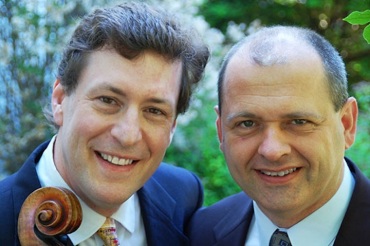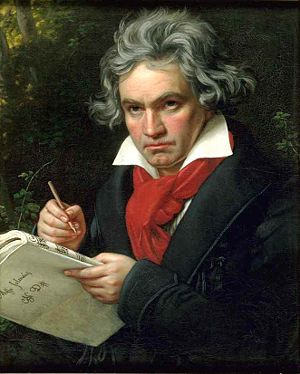The Well-Tempered Ear
Classical music Q&A: Do Beethoven’s sonatas for cello and piano evolve, and how important are they in the overall cello repertoire? Cellist Parry Karp and pianist Eli Kalman discuss their upcoming performances on Friday night and Sunday afternoon at Farley’s House of Pianos of Beethoven’s complete music for piano and cello. Part 1 of 2.
4 Comments
By Jacob Stockinger
This weekend brings one of the major and memorable events of the current season: Performances in two parts of the complete original works for cello and piano by Ludwig van Beethoven (1770-1827).
The performances will take place this Friday night at 7:30 p.m. and this Sunday afternoon at 4:30 p.m. (NOT 3:30 as mistakenly first announced) in the concert hall (below) at Farley’s House of Pianos, 6522 Seybold Road, on Madison’s far west side, near West Towne Mall.
The performers are longtime collaborators: University of Wisconsin-Madison professor of cello and Pro Arte Quartet cellist Parry Karp and UW-Oshkosh professor of piano Eli Kalman, who received his doctoral degree from the UW-Madison School of Music.
Tickets are $25 for each individual concert or $40 for the package of two. For more information call (608) 271-2626, go to Farley’s website. Here is a link:
http://www.farleyspianos.com/pages/events_main.html
Here are the programs for the two concerts:
Friday at 7:30 p.m.: Sonata In C Major, Op. 102 No. 1 (1815); Sonata in F Major, Op. 5 No. 1 (1796); Seven Variations on a theme “Bei Männern, welche Liebe fühlen” from Mozart‘s opera, The Magic Flute, WoO 46 (1801); Sonata In D Major, Op. 102 No. 2 (1815)
Sunday at 4:30 p.m.: Twelve Variations on a Theme from Handel’s Oratorio “Judas Maccabeus,” WoO 45 (1796); Sonata In G Minor, Op. 5 No. 2 (1796); Twelve Variations on a theme “Ein Mädchen oder Weibchen” from Mozart’s opera, The Magic Flute, Op. 66 (1798); Sonata in A Major, Op. 69 (1807-8)
Both Parry Karp (below left) and pianist Eli Kalman (below right) agreed to answer a wide-ranging email Q&A. Their responses will run in two parts today and tomorrow. Today is Part 1:
Where would you place the Beethoven cello sonatas and his other works in the overall cello repertoire? What makes them challenging individually and as a whole?
Parry Karp: The Beethoven Cello Sonatas are amongst the most important works in the cello-piano duo repertoire. These are seminal works, in that up until the time that Beethoven wrote the first two Sonatas, Op. 5, there had really never been works written for this combination of instruments in which both instruments had important music to play and were equal partners.
Before that, the duos for cello and keyboard had the cello performing the important music and the keyboard part was basically accompanying. However, Beethoven changed that for good with his generous duo compositions for piano and cello. While there was a wonderful precedence for duo repertoire by Mozart for keyboard and violin (well over 30 compositions) Mozart managed only 11 measures of a Sonata for piano and cello and then stopped!
Because there wasn’t a history of duo sonatas for piano and cello, I think Beethoven (below) felt freer to experiment when he wrote the Cello Sonatas. He wrote them throughout his entire career and with the exception of the great A Major Sonata, Op. 69, they are revolutionary works.
The first two Sonatas of Op. 5 were written in 1796 when Beethoven was a brilliant young performing pianist and composer. These two Sonatas were written for the only “concert tour” Beethoven ever took. They are dedicated to King Frederick of Prussia who gave Beethoven a gold snuff box for his efforts. The form of these early Sonatas is very unusual. Both of them are in two movements, and the first movements have very lengthy slow introductions.
As far as I know, no sonata allegro movement written up until these two Op. 5 Sonatas had a slow introduction that approaches the size and emotional scope of the ones found in these works. Also, the first movements of these two Sonatas are a bigger canvas than the first movement of any Haydn or Mozart Symphony, or previous work written by Beethoven up to this time.
The late Op. 102 Cello Sonatas are virtually the only works that he wrote in 1815 and are basically the first works completely in his “late style.” If you know and love the five late Beethoven Piano Sonatas and haven’t heard these late Cello Sonatas, you are in for a treat getting to know them. The Op. 102 Cello Sonatas were actually written just before the Op. 101 Piano Sonata.
Most striking for me is how the relatively smaller Op. 102, No. 2, Cello Sonata seems to lead to the great and grand-scale “Hammerklavier” Piano Sonata, Op 106. Both works have incredibly profound and personal slow movements that lead into wild and thrilling last movement fugues; and there are even motivic similarities between the two works. It is as if Beethoven experimented with these new ideas initially with his new ensemble (the piano-cello duo) and then went to town with these ideas and expanded them in the Op. 106 Piano Sonata.
These works, as a whole, inspired composers from this time forward to the possibilities of writing outstanding works for this duo combination and the influence was immediate; both Mendelssohn and Hummel wrote Cello Sonatas that are strongly influenced by Beethoven’s Op. 69 Sonata. This influence has continued to the present day.
Eli Kalman: It is in some way confusing that although the cello and piano repertoire starts with Beethoven, the complete cycle of these works makes it sound more like the genre starts and ends at the same time. Playing all the works grants a sense of totality and the gratification of a complete journey.
The confusion is only enhanced by the unusual shapes and ideas of the early sonatas because of the formal eccentricity and the variety of what Beethoven deliberately planned to sound fresh and “unpredictable.
How does the writing for the two parts – cello and piano – evolve separately and together from the first works to the last? Do the cello works show the same kind of musical and spiritual development as, say, the piano sonatas and string quartets?
Parry Karp: The works do evolve in a similar way to the piano sonatas and string quartets, but I am not sure they get better. The early works are amazing and compelling on an ultimate scale.
Eli Kalman: If the fugue of the last sonata would not contradict my statement, I would be comfortable saying that the composer moves each sonata towards the idea of “less is more” in the way he treats the piano writing. The later works prefer lesser notes and more transparency serving a very different affect.
Moving away from great classical principles of Op. 69 (the first movement is performed by pianist Glenn Gould and cellist Leonard Rose in a popular YouTube video), which is the ultimate expression of duo-sonata “perfection,” must have felt like a compositional necessity. Beethoven defines an unmatched and new type of musical sophistication.
Tomorrow: Do the performers have favorite cello sonatas by Beethoven? What should audiences listen for? How did the performers first get together?


